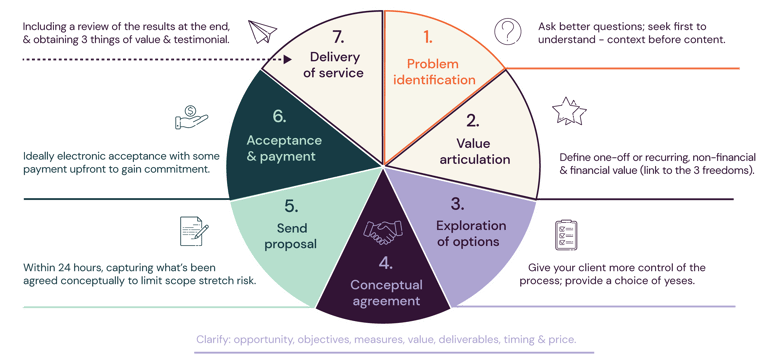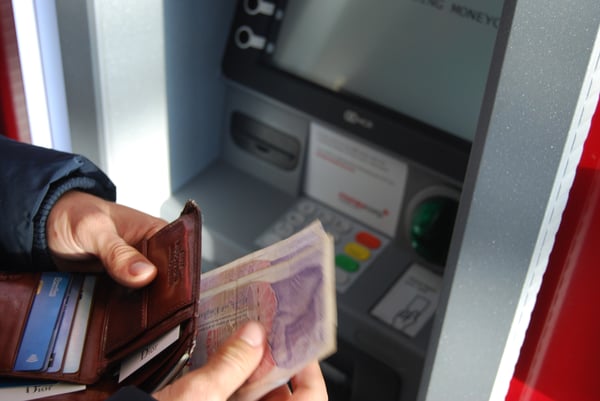Proposals are not ‘Sales Engines’
.jpg?width=50&name=Mark%20(2).jpg) Mark Jenkins, CA
·
2 minute read
Mark Jenkins, CA
·
2 minute read
I've seen it written that proposals are your sales engine - this is simply not true. The proposal is essential; but it's only one of the steps in the sales process:
The 7 Steps in the Sales Process:
- Problem identification.
- Value articulation.
- Exploration of options.
- Conceptual agreement.
- Proposal documentation.
- Acceptance and payment.
- Delivery of service.

Problem identification
All selling is problem solving in some way, shape or form.
Either you’re solving a problem by delivering the service or you’re helping to avoid a problem occurring in future. The important point is that the Accountant and the client must understand what the problem is. Accountants therefore must create opportunities to discuss the problems and challenges that their clients are facing.
Value articulation
Establishing the value of solving a problem helps the client see the benefit of proceeding with the service you'll provide.
Value is a perception until it becomes a reality and, unless the client proceeds with the service, they won’t see that reality. We must clarify what is possible for the client during client onboarding, in order for them to part with their money. For example, they’re unlikely to know the potential tax savings or cashflow improvement that is possible by working with you... so we need to paint a clear picture.
Exploration of options
There are typically a range of ways you can help the client to solve an identified problem.
Each option will provide a different level of value and have a different associated cost. By exploring different options with your client you give them greater control over how they’d like to proceed; a ‘choice of yeses’ also increases your chances of making a sale.
Conceptual agreement
Arguably, when the client has reached conceptual agreement to proceed with the service, that is when the sale is really made.
There are seven parameters on which to achieve conceptual agreement:
- The opportunity or problem to be solved.
- The objectives of working together.
- The measures of success.
- The value to be gained.
- The deliverables.
- The timing.
- The price.
Without all seven being agreed upon there is a risk that the project will result in scope stretch or an unhappy client.
Conceptual agreement is the precursor to sending a proposal to your client for the work – it is NOT the proposal. Ideally, all parameters should be discussed during a meeting or phone call.
Proposal documentation
Upon conceptual agreement, the proposal should quickly be provided (ideally within 24 hours).
The longer it takes to get the proposal out, the lower the chance of it being formally accepted. The client will become distracted with other pressing matters and their memory of the value discussion will diminish. It doesn't need to be a complicated document, but it should confirm what is being delivered, it’s cost and what happens next.
You need a templated system for proposal writing to ensure you get them out quickly. This should allow you to easily capture the 7 parameters of conceptual agreement.
In today’s world, all proposals should ideally be digital and paperless to make it easier for clients to accept and to avoid postal delays.
There are nine steps to every proposal (according to Alan Weiss's 9 Step Proposal Methodology):
- Situation appraisal.
- Objectives.
- Measures of Success.
- Value.
- Mutual responsibilities.
- Timing.
- Deliverables.
- Price.
- Acceptance.
Acceptance and payment
Obviously, the sale is not made until the proposal has been accepted... you could argue it's not made until payment has been received.
It is good practice to require some form of payment up-front so that there is a real commitment from the client to proceed with the work (and an obligation for the Accountant to deliver as well!). Payment might be 100% up-front (perhaps with a small discount) or 50% on acceptance and 50% on completion of the service.
Delivery of service
The final step in meeting the definition of the sale (the exchange of a product or service for money) is delivery of the service.
Ideally, at the end of the delivery piece, the Accountant should check in that the value promised has been delivered. Assuming the client is happy, it’s also a great time to ask for a testimonial for future marketing. Of course, if they’re not happy with the value then you’ll need to pull out that proposal to check if you've missed anything.
.png?width=678&height=100&name=6424e325e353044bbb32c8e4_The%20Gap_Logo_Horizontal_Violet_RGB%20(3).png)



